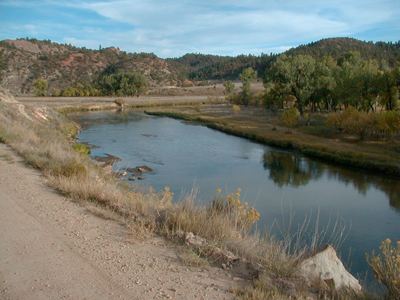Date 29 August 1865 | Result U.S. victory | |
 | ||
200 soldiers, 70 Indian scoutstwo artillery pieces 500, including women and children 5 killed2 wounded ~ 63 killed, including women and children18 women and children captured Similar Powder River Expedition, American Indian Wars, Wagon Box Fight, Battle of Platte Bridge, Fetterman Fight | ||
Battle of the tongue river august 29 1865
The Battle of the Tongue River, sometimes referred to as the Connor Battle, was an engagement of the Powder River Expedition of 1865, directed against the Cheyenne, Arapaho and Lakota Sioux. In the engagement, Soldiers and Indian Scouts attacked and destroyed an Arapaho village.
Contents
- Battle of the tongue river august 29 1865
- Battle of the tongue river
- Background
- The battle
- Casualties
- Aftermath
- Officers in the Engagement
- Order of battle
- The Battlefield today
- References
Battle of the tongue river
Background
Major General Grenville M. Dodge assumed command of the Department of the Missouri in 1865. Dodge ordered a punitive campaign to suppress the Cheyenne, Sioux, and Arapaho Indians who had been raiding overland mail routes, wagon trains, and military posts along the Oregon and Overland trails. He gave tactical command of the Powder River Expedition, as it was called, to Brigadier General Patrick Edward Connor, commander of the District of Utah.
The expedition was a multi-pronged affair involving 2,600 soldiers, civilians, and Indian scouts. Three columns of soldiers were to descend upon the Powder River Country of Wyoming and Montana, unite, and "make vigorous war upon the Indians and punish them so that they will be forced to keep the peace." Connor was in overall command and led the westernmost or left prong of the expedition. The forces under his direct command consisted of 380 soldiers: 14 men of the 2nd Missouri Light Artillery, 6 companies of the 6th Michigan Cavalry, Company F of the 7th Iowa Cavalry, and Companies E, and K of the 11th Ohio Cavalry. Also included were civilian guides headed by mountain man Jim Bridger, 95 Pawnee scouts under Captain Frank J. North, 84 Omaha and Winnebago scouts under Captain E. W. Nash, and 195 civilian teamsters. Connor left Fort Laramie on July 30, 1865, marching north. He established a fort on the upper Powder River which he named Fort Connor (later called Fort Reno) and left some of his men there to staff the fort.
The battle
Jim Bridger saw the smoke of an Indian village and Connor sent out Frank North and two Pawnees to find the village. On August 28, the scouts reported back that they had found the village about 35 miles west of Connor's force. Connor quickly collected his most mobile soldiers, consisting of about 200 soldiers with two mountain howitzer cannon and 40 Omaha and Winnebago and 30 Pawnee scouts, and marched that night toward the village. With Bridger leading them, they reached the village about eight a.m. the next morning.
The soldiers charged the village, having achieved complete surprise. The howitzers pounded the village while the soldiers rushed in, catching the Indians unprepared. In the melee, there was a great deal of indiscriminate firing and women and children were killed as well as warriors. The village, led by Black Bear and Medicine Man, had about 500 inhabitants. Many of the men were absent for a raid on the Crow along the Big Horn River, leaving mostly old men, women, and children in the village. After the initial attack the few able warriors in the village put up an effective defense, retreating about twelve miles up Wolf Creek while covering the flight of the women and children.
Most of the soldiers remained in the village to loot and burn the tipis, but Connor and about 30 men, including 15 Pawnee, pursued the retreating Arapaho. The Arapaho counterattacked and Connor, his horses spent, was forced to retreat back to the village. The soldiers there completed their work of destruction as the Indians harassed them from a distance, attempting to re-capture their horse herd. The soldiers abandoned the destroyed village about 2:30 that afternoon, North and the Pawnee leading and driving before them more than 500 captured horses. The Arapaho persisted in their attacks but were unable to re-capture the horses, eventually giving up the effort. At 3 a.m. the next morning, the soldiers reached their starting point, having covered more than 70 miles and fought a battle in less than 36 hours.
Casualties
Connor claimed to have killed 63 Arapaho, including 35 warriors, with a loss to himself of five dead and two seriously wounded. He singled out four Winnebago, including the chief, Little Priest, plus North and 15 Pawnee for bravery. Connor strictly forbade looting and burned all the property collected during the occupation of the village. He released the women and children he had captured. The battle was hailed as a great victory on the frontier.
Aftermath
The Arapaho were apparently not cowed by the destruction of one of their villages. Two days later, Arapaho killed Captain Osmer F. Cole of the 6th Michigan Cavalry while he was escorting the Sawyers Expedition. The next day on September 1, 1865, 100 or more Arapaho attacked the well-armed Sawyers train of 60 ox wagons along the Tongue River under the command of Lieutenant Colonel James A. Sawyers. They killed three men, stole livestock, and kept the wagon train under siege for two weeks until General Connor's soldiers rescued it. The effectiveness of the Arapaho attack was limited by their shortage of powder for their muskets, and many of the bullets they fired failed to penetrate the skin of either men or oxen. (See Sawyers Fight)
Officers in the Engagement
Order of battle
United States Army, Powder River Expedition, August 29, 1865.
Native Americans
The Battlefield today
A portion of the battlefield is preserved by the Connor Battlefield State Historic Site in Ranchester, Wyoming. It is listed on the National Register of Historic Places.
